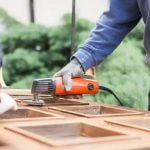Woodwork is a beautiful and timeless addition to any home, providing character and elegance. However, before you apply a fresh coat of paint to your woodwork, it’s crucial to thoroughly clean the surface. Cleaning woodwork before painting is essential for achieving a professional finish and ensuring that the paint adheres properly.
Cleaning woodwork serves several important purposes. First and foremost, it removes any dirt, dust, or grime that may have accumulated over time. This not only improves the appearance of the wood but also prevents these particles from becoming trapped under the paint. Additionally, cleaning helps remove any loose or peeling paint, creating a smooth surface for the new coat of paint to adhere to.
Different types of woodwork may have different cleaning requirements. For example, intricate details on crown molding or baseboards may require more careful attention than flat surfaces like doors or window frames. It’s important to understand these differences in order to effectively clean each type of woodwork without causing damage.
To properly clean your woodwork, you’ll need to gather the necessary cleaning supplies and tools. This may include mild detergent or cleaner specifically formulated for wood surfaces, a soft sponge or cloth, a bucket for mixing cleaning solutions, and potentially a ladder or step stool if you’re working on higher areas.
In this article, we will provide step-by-step guidance on how to properly clean woodwork for painting. We’ll cover techniques and best practices for removing dust, dirt, loose paint, as well as how to address common issues that may arise during the cleaning process. We’ll also discuss precautions you should take to protect adjacent surfaces and yourself while cleaning.
By following proper cleaning techniques and taking care of your woodwork before painting, you can achieve a flawless finish that will enhance the beauty of your space and ensure lasting results. So let’s dive in and learn how to clean woodwork for painting.
Understanding the different types of woodwork and their cleaning requirements
Before diving into the process of cleaning woodwork for painting, it is crucial to understand the different types of woodwork and their specific cleaning requirements. Different types of woodwork may include baseboards, window frames, doors, crown molding, and trim. Each type may be made from a variety of woods, such as pine, oak, or cherry, and will require unique care.
Pine woodwork is common in many homes and has softwood properties. It is important to handle pine woodwork delicately during the cleaning process to prevent any damage. On the other hand, oak woodwork is strong and durable but can have stubborn stains or grime buildup that needs extra attention during cleaning.
Cleaning cherry woodwork requires special caution as it is a more delicate type of wood with a softer finish. Avoid using abrasive cleaners or scrubbing forcefully when working on cherry wood surfaces.
Knowing the specific type of wood in your home will help you determine the best approach for cleaning. Consult with professionals or do research to identify the proper techniques and products suitable for your particular woodwork since each type may require a tailored method to maintain its quality.
In addition to considering the type of wood involved, it is also important to take note of any existing finishes on the surface of the woodwork. Some finishes may have specific cleaning requirements to avoid damaging or altering them. Therefore, familiarize yourself with appropriate techniques that are safe for both the surface finish and underlying material before proceeding with any cleaning methods. This knowledge will allow you to confidently clean your woodwork without compromising its integrity or appearance.
Gathering the necessary cleaning supplies and tools
One of the essential steps in cleaning woodwork for painting is to gather the necessary cleaning supplies and tools. Having the right materials will ensure that the cleaning process is effective and efficient, resulting in a clean surface ready for painting. Here are some key items you will need:
- Cleaning Solutions: Depending on the type of woodwork and its condition, you may need different types of cleaning solutions. For general cleaning, a mild detergent mixed with water can be used. For tougher stains or grease buildup, a stronger cleaner or solvent may be required. It’s important to choose a cleaning solution that is appropriate for the specific type of wood and finish.
- Scrub Brushes: Different sizes and types of scrub brushes may be needed depending on the size and intricacy of the woodwork. Soft-bristle brushes are usually suitable for delicate surfaces, while stiffer brushes may be required for more stubborn dirt or stains.
- Sponges or Cloths: These are useful for applying the cleaning solution and wiping away dirt or residue. Microfiber cloths are highly recommended as they are effective at capturing dust particles without scratching the surface.
- Bucket: A bucket will be needed to mix the cleaning solution and hold water for rinsing off the woodwork.
- Protective Gear: It is important to protect yourself during the cleaning process. Gloves, goggles, and a mask can prevent skin irritation, eye injuries, and inhalation of fumes from harsh cleaners or solvents.
- Ladder or Step Stool: If you need to clean high areas such as crown molding or trim, a ladder or step stool will come in handy to reach those elevated spots safely.
Having these supplies readily available before starting the woodwork cleaning process will save time and ensure that you have everything you need within reach while working. Additionally, it is crucial to read product labels and follow safety instructions when using any chemical-based cleaners or solvents.
Preparing the woodwork surface for cleaning (removing dust, dirt, and loose paint)
Before you can begin the process of cleaning woodwork for painting, it is crucial to properly prepare the surface. This involves removing any dust, dirt, and loose paint that may hinder the cleaning process and affect the final paint finish. Taking the time to prepare the woodwork surface effectively will ensure that the cleaning process is thorough and successful.
To start, use a soft bristle brush or vacuum cleaner with a brush attachment to remove any loose dust or debris from the woodwork. Pay close attention to corners, crevices, and intricate details where dust tends to accumulate. By eliminating loose particles beforehand, you can prevent them from creating streaks or scratching the woodwork during cleaning.
Next, assess whether there are areas with chipped or peeling paint. These areas require special attention as they can compromise the overall finish of your painting project if not properly addressed. Use a putty knife or scraper to gently remove any loose paint chips. Be careful not to scrape too aggressively as this can damage the woodwork further.
Additionally, it is important to address any greasy or oily residue on the woodwork surface. Use a mild detergent solution or a mixture of warm water and vinegar to clean these areas thoroughly. Apply the solution with a sponge or soft cloth and gently scrub in circular motions. Rinse with clean water afterward to remove any soap residue.
By taking these necessary steps to prepare the woodwork surface for cleaning, you are ensuring that your painting project starts off on the right foot. Eliminating dust, dirt, and loose paint provides a clean canvas for applying new paint and guarantees better adhesion and a smoother finish. With proper preparation, you are well on your way to achieving professional-looking results for your woodwork painting.
Step-by-step guide on how to clean woodwork for painting (including proper techniques and best practices)
Cleaning woodwork before painting is an essential step to ensure a smooth and professional finish. By removing dirt, dust, and loose paint from the surface, you improve adhesion and create a clean canvas for your paint to adhere to. Here is a step-by-step guide on how to clean woodwork for painting, including proper techniques and best practices:
- Gather the necessary cleaning supplies and tools: Before starting the cleaning process, gather all the supplies you’ll need. This may include a bucket of warm water, mild detergent or wood cleaner, a sponge or soft cloth, scrub brush or toothbrush for hard-to-reach areas, sandpaper or sanding block (if needed), and clean towels.
- Prepare the woodwork surface for cleaning: Start by removing any loose dirt, dust, or debris from the woodwork surface. Use a soft brush or vacuum with a brush attachment to remove loose particles. Next, scrape off any peeling or flaking paint using a putty knife or scraper. Be careful not to damage the wood surface while doing this.
- Clean the woodwork using proper techniques: Fill a bucket with warm water and add some mild detergent or wood cleaner as per the manufacturer’s instructions. Dip a sponge or soft cloth into the soapy water solution and gently scrub the woodwork surface in small sections. Use a scrub brush or toothbrush for intricate details and corners.
- Start from top to bottom: Begin cleaning at the top of the woodwork and work your way down.
- Avoid excessive moisture: Ensure that your sponge or cloth is damp rather than soaking wet to prevent over-saturation of the wood.
- Rinse frequently: Rinse your sponge or cloth frequently in clean water to avoid spreading dirt around.
- Change water regularly: If you have multiple sections to clean, change the soapy water solution when it gets dirty.
- Dry immediately: After cleaning each section, dry it immediately using clean towels to prevent water from soaking into the wood.
By following these steps and using the proper techniques, you can effectively clean your woodwork for painting. Remember to take your time and be thorough in your cleaning process to achieve the best results. In the next sections, we will address common issues that may arise during the cleaning process and provide tips on how to overcome them.
Addressing common issues during the cleaning process and how to overcome them
When cleaning woodwork for painting, it is common to encounter certain issues that may pose challenges. However, with the right techniques and solutions, these issues can be overcome effectively. This section will address some of the common issues that may arise during the cleaning process and provide tips on how to overcome them.
Stubborn Stains
One common issue when cleaning woodwork is dealing with stubborn stains. These stains may include grease, oil, markers, or even water marks. To remove stubborn stains from woodwork, start by gently scrubbing the area using a mild detergent or vinegar solution. Use a soft cloth or sponge to avoid scratching the surface.
For tougher stains, you can create a paste using baking soda and water and apply it to the stained area. Let it sit for a few minutes before scrubbing gently. Rinse the woodwork thoroughly after removing the stain.
Paint Spatters
Paint spatters are another issue that frequently occurs when painting woodwork surfaces or nearby walls without proper protection. If you find paint spatters on your woodwork, avoid scraping them off with a sharp object as it may damage the surface.
Instead, try using a plastic scraper or credit card to gently lift off as much paint as possible without applying excessive force. For dried paint spots, moisten a cloth with rubbing alcohol and gently rub the affected area until the paint lifts off.
Mold and Mildew
Mold and mildew growth can be quite common in areas with high moisture levels or inadequate ventilation. When cleaning woodwork affected by mold or mildew, it is crucial to wear protective gear such as gloves and a mask to avoid inhaling spores or coming into direct contact with them.
To clean mold and mildew from woodwork surfaces, mix equal parts of bleach and water in a spray bottle and spray onto the affected area. Allow the solution to sit for a few minutes, then scrub gently with a soft brush or sponge. Rinse thoroughly with clean water and dry the woodwork completely to prevent further mold growth.
By being aware of these common issues and how to overcome them, you can ensure a successful cleaning process when preparing woodwork for painting. Remember to be patient and cautious while addressing these issues, as using excessive force or harsh chemicals may damage the wood surface. With proper techniques and solutions, you can achieve clean woodwork that will provide a smooth base for your paint application.
Drying and inspecting the woodwork after cleaning
After thoroughly cleaning the woodwork, it is crucial to allow it to dry properly before proceeding with the painting process. Drying the woodwork ensures that there is no moisture trapped in the surface, which can lead to paint adhesion issues and ultimately affect the final result.
Allowing Sufficient Drying Time
After cleaning the woodwork, it is essential to give it enough time to dry completely. The drying time can vary depending on various factors such as temperature, humidity, and the type of cleaning solution used. As a general guideline, allowing at least 24 hours for drying is recommended. However, if you are unsure about the drying time, it is best to refer to the manufacturer’s instructions on your chosen cleaning product.
Inspecting the Woodwork
Once the woodwork is completely dry, it is important to inspect it carefully for any remaining dirt or imperfections. Check for any stubborn stains or areas that might require additional cleaning or touch-ups. Use a clean cloth or your fingertips to run along the surface of the woodwork and feel for any rough patches or protrusions that need addressing before moving forward.
Sanding (if necessary)
If you notice any rough patches or loose paint that could not be removed during the cleaning process, light sanding may be required. Use fine-grit sandpaper or a sanding block to smooth out those areas gently. This step will help create a smooth and even surface for painting.
Ensuring Proper Ventilation
During this stage of drying and inspecting the woodwork, ensure good ventilation in the area by opening windows and doors if possible. Adequate airflow speeds up drying time and helps remove any lingering odors from cleaning products.
By following these steps of drying and inspecting your woodwork after cleaning, you can ensure that the surface is ready for painting. Taking the time to thoroughly dry and inspect the woodwork not only helps achieve a professional paint finish but also reduces the chances of any issues arising during the painting process.
Precautions to take when cleaning woodwork for painting (protecting adjacent surfaces, wearing protective gear)
When preparing to clean woodwork for painting, it is important to take certain precautions to ensure the process goes smoothly and does not cause any damage. Protecting adjacent surfaces and wearing proper protective gear should be top priorities. Here are some important precautions to keep in mind:
- Protect adjacent surfaces: Before you begin cleaning your woodwork, it is crucial to protect any adjacent surfaces that may be at risk of getting damaged by water, cleaning solutions, or paint. Use plastic drop cloths or tarps to cover floors, furniture, or any other items that are in close proximity to the woodwork. This will prevent any accidental spills or splatters from causing harm.
- Wearing protective gear: When working with cleaning solutions and potentially harmful chemicals, it is essential to protect yourself with appropriate gear. Wear gloves to shield your hands from harsh cleaners and solvents. Safety glasses should be worn to protect your eyes from dirt particles and splashes of cleaning agents. Additionally, consider wearing a mask or respirator if you are working with strong chemicals that produce fumes.
- Ventilation: To further ensure your safety during the cleaning process, make sure there is proper ventilation in the area where you are working. Open windows and doors if possible, or use fans to circulate air and carry away any fumes generated by the cleaning products.
Remember, these precautions are not only important for your safety but also for protecting the quality of the surrounding areas as you work on cleaning and painting your woodwork.
By taking these necessary precautions before starting the cleaning process, you can minimize the risk of accidents or damage occurring during this important step of preparing woodwork for painting.
Conclusion
In conclusion, it is crucial to prioritize cleaning woodwork before embarking on a paint project. By thoroughly preparing the surface, you can ensure a professional and long-lasting paint finish. Understanding the different types of woodwork and their specific cleaning requirements is essential in choosing the appropriate cleaning supplies and tools.
Following a step-by-step guide, such as the one mentioned in this article, will help you achieve optimal results. Proper techniques and best practices, such as removing dust, dirt, and loose paint before cleaning, should not be overlooked. Taking your time to address common issues that may arise during the cleaning process and knowing how to overcome them can save you valuable time and effort.
After thoroughly cleaning the woodwork, it is important to properly dry and inspect the surface before proceeding with any painting task. This ensures that no moisture or remaining contaminants interfere with your paint application. Lastly, taking precautions like protecting adjacent surfaces from splatters or spills and wearing protective gear will guarantee a safer working environment.
Frequently Asked Questions
What is the best way to clean wood before painting?
The best way to clean wood before painting is to start by removing any loose dirt and debris using a soft brush or vacuum cleaner. After that, wipe the surface with a damp cloth to remove any remaining dust or grime. For tougher stains or grease spots, a mild soap and water solution can be used.
It’s important to avoid using harsh cleaners or abrasives that may damage the wood surface. Once the wood is clean, allow it to dry completely before proceeding with the painting process.
How do you remove grease from wood before painting?
Removing grease from wood before painting can be done in a few different ways depending on the severity of the grease stain. For light grease spots, gently wiping the area with warm soapy water and a cloth might be effective. More stubborn grease stains may require using a degreasing agent like trisodium phosphate (TSP) mixed with water and applied to the stain.
Scrubbing the area gently with a soft brush can help lift the grease. Rinse thoroughly after cleaning and make sure to let the wood dry completely before applying paint.
Should wood be washed before painting?
Yes, it is generally recommended to wash wood before painting. Cleaning the surface helps to remove any dirt, dust, oils, or other contaminants that could interfere with adhesion and affect the paint finish. By washing the wood, you create a clean canvas for better paint adherence and ensure that your paint job will last longer without issues such as peeling or chipping.
Additionally, rinsing off any cleaning agent residue is essential to prevent chemical interactions between these substances and subsequent layers of paint or primer. Taking these steps will give you a smoother and more professional-looking finish when painting wood surfaces.

Hi everyone! I’m a woodworker and blogger, and this is my woodworking blog. In my blog, I share tips and tricks for woodworkers of all skill levels, as well as project ideas that you can try yourself.





